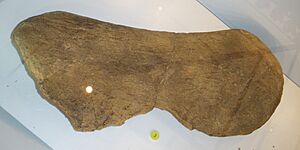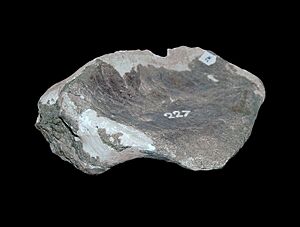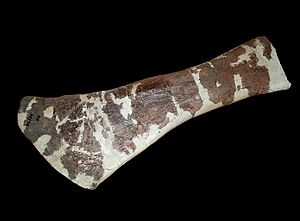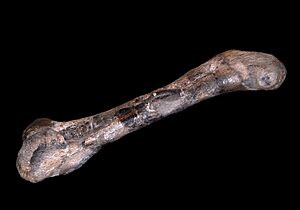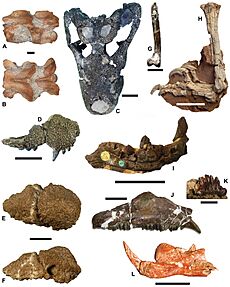Magyarosaurus facts for kids
Quick facts for kids Magyarosaurus |
|
|---|---|
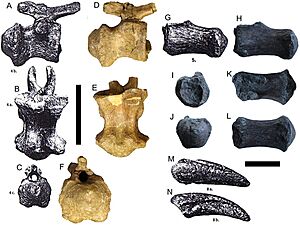 |
|
| Fossil bones used to identify Magyarosaurus dacus | |
| Scientific classification | |
| Synonyms | |
|
Magyarosaurus (pronounced "MAG-yar-o-SAW-rus") means "Hungarian lizard." It was a special type of long-necked sauropod dinosaur that was surprisingly small! This dinosaur lived in what is now Romania during the late Cretaceous period, about 71 to 66 million years ago.
Unlike its giant relatives, Magyarosaurus was one of the smallest adult sauropods ever discovered. It was shorter than a small car and weighed less than a cow. The only known species is Magyarosaurus dacus. Scientists think it was a type of titanosaur and was closely related to another dinosaur called Rapetosaurus.
Contents
How Was Magyarosaurus Discovered?
The first fossils of Magyarosaurus were found way back in 1895 in the Hunedoara region of Romania. At that time, this area was part of Hungary. Bones from at least ten different dinosaurs were found.
In 1915, a scientist named Baron Franz Nopcsa first studied the bones. He named the dinosaur Titanosaurus dacus. The name "dacus" comes from the Dacians, an ancient people who lived in that area thousands of years ago.
Later, in 1932, another scientist named Friedrich von Huene realized this dinosaur was different enough to need its own genus. He gave it the new name Magyarosaurus. "Magyar" is another word for Hungarian, honoring the place where it was first studied.
Over the years, scientists have found many more bones, mostly from the tail and back. However, no one has ever found a skull. In a very exciting discovery, 14 fossil eggs were also found that might have belonged to Magyarosaurus.
What Did Magyarosaurus Look Like?
Magyarosaurus was a very small sauropod. It grew to be only about 2 to 3 meters (7 to 9 feet) long and weighed less than 1,000 kilograms (2,200 pounds). This is about the size of a large horse, which is tiny for a sauropod!
Its small size is its most unique feature. None of its close relatives were this small. Another cool feature of Magyarosaurus was that it had dermal armor. This means it had bony plates, called osteoderms, embedded in its skin for protection.
A Dwarf Among Giants
Why was Magyarosaurus so small when its relatives were so huge? The answer is a fascinating process called insular dwarfism, or "island dwarfism."
Life on an Island
During the Cretaceous period, much of Europe was a series of islands. Magyarosaurus lived on one of these, known today as the Hațeg Island. On an island, resources like food are limited. Also, there might not be any large predators to worry about.
In this environment, being big is not an advantage. Smaller animals need less food to survive. Over many generations, the sauropods on Hațeg Island evolved to become smaller and smaller. This is why Magyarosaurus became a dwarf dinosaur. Other dinosaurs on the island, like Rhabdodon and Struthiosaurus, were also smaller than their mainland relatives.
How Do We Know They Were Adults?
For a long time, some scientists wondered if the small Magyarosaurus fossils were just from baby or teenage dinosaurs. But in 2010, a team of researchers studied the bones up close.
They looked at the bone tissue under a microscope, a science called histology. Just like trees have growth rings, bones also have lines that show how an animal grew. The bone patterns of Magyarosaurus showed that even the smallest ones were fully grown adults. They just grew slowly and stopped growing at a small size.
Built-in Armor and Fossil Eggs
Scientists have found an osteoderm (a piece of skin armor) that belonged to Magyarosaurus. This discovery proves that this small sauropod had a way to protect itself.
Even more exciting, fossil eggs have been found in the same area. These eggs might have been laid by Magyarosaurus. Some of the eggs even had tiny embryos inside! This gives us a rare peek into the life cycle of these amazing dinosaurs.
The World of Magyarosaurus
Magyarosaurus lived in a unique place called the Hațeg Basin, which was a large island during the Late Cretaceous. The climate was warm, with both dry and rainy seasons. Over time, the area became more of a wetland.
This "Island of the Dwarf Dinosaurs" was home to many other interesting creatures. Magyarosaurus shared its world with:
- Telmatosaurus, a small duck-billed dinosaur.
- Zalmoxes, another plant-eating dinosaur.
- Struthiosaurus, a small armored dinosaur.
- Balaur, a strange bird-like predator with two large claws on each foot.
- Hatzegopteryx, a giant flying pterosaur that was one of the top predators on the island.
- Ancient turtles like Kallokibotion.
Many of the plant-eating dinosaurs on the island were dwarfs, just like Magyarosaurus. It was a special ecosystem where being small was the key to survival.
See also


